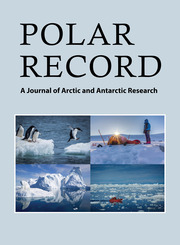Article contents
Monitoring the transformation of historic features in Antarctica and Svalbard: local processes and regional contexts
Published online by Cambridge University Press: 04 December 2009
Abstract
Historical sites in Antarctica and Svalbard contain the material remains of past activities of exploration and exploitation of these regions. These sites have been subject to transformation by cultural and non-cultural (natural) processes since their abandonment to the present. For research and management purposes it is important to monitor and explain these changes. This article focuses on the transformation of historic features in Antarctica and Svalbard as assessed through repeat photography. Seven historical features were selected representing a range of site types and past and present site functions. Data collection was based on the opportunistic reproduction of photographs of historic features taken up to 20+ years previously. Data analysis was performed using the concepts of site formation processes developed by M.B. Schiffer (1983, 1987). Time-serial changes were observed in the seven photo-couples examined in the present instance. No feature degraded significantly during the monitoring period; rather, several features were restored in different ways. Changes were interpreted to result from a range of cultural processes (including conservation, research, and tourism) and natural processes (mainly wind action). Local changes take place in the context of broader regional developments in Antarctica and Svalbard. Despite the ‘time capsule’ narratives about some sites, historical sites in the polar regions are dynamic entities that not only reflect the past as it once was but are also a window onto the present.
Information
- Type
- Research Article
- Information
- Copyright
- Copyright © Cambridge University Press 2009
References
- 7
- Cited by

